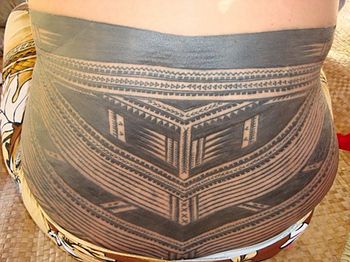Samoan Tatoo
Samoa is famous for its traditional tattoo. Samoans call it Pe'a. Tradition of Samoan tattoo is more than 2000 years old. According to an ancient Samoan legend the tattoo making was introduced to Samoans by Taema and Tilafaiga. They were two daughters of the Samoan king Tui Manu'a. English word Tattoo derives from Samoan „Tatau“ (meaning "to hit or strike (ta) with the au (tool)").
 Pe'a - Samoan traditional tattoo
Pe'a - Samoan traditional tattoo
There is a traditional Samoans belief that the pain of the Pe’a is sort of compensation for the pain woman suffers during child birth. Samoans say "Fanau le teine fana fanau, fanau le tama le tatau" or in English "If a girl is born it must bear the pain of birth, if a boy is born it must bear the pain of tatau".
Before the arrival of Christian missionaries around 1830 all men of Samoa had traditional tattoo. Because of their influence only chiefs' sons were tattooed. Nowadays there is strong revival of Pe'a among both men and women.
Pe'a is being etched on to a human body in the traditional way by Tafuga (tattoo artist). The skill of tattooing is often passed from father to son.
Tools used by Tafuga have not been changed a lot since the beginning of tradition.
 tattoo tools on mat (Photo by Michael Lothian 2001.)
tattoo tools on mat (Photo by Michael Lothian 2001.)
Au is a tool made from a short piece of bamboo or some other light wood and a small piece of turtle shell. There is a comb attached to this. The comb is made from boar's teeth, sharpened bone or even sharks teeth. Tafuga dips the comb in a special black ink. The ink is made from the soot of burnt candlenut shells that is mixed with some coconut oil into a smooth paste.
The second tool used in traditional Samoan tattooing is a stick which serves as kind of small mallet. It is used to constantly tap the ink soaked Au. That way Au pierces the surface of the skin.
Traditional Samoan tattooing is a painful process. With breaks It often lasts for several days or even weeks. Because of all the pain person being tattooed has constant assistance, both physical and spiritual.
The tattoo starts from the lower back and reaches the ribcage underneath of the armpits. A samoan tattoo also covers the whole buttocks and sides of the torso and moves over the groin area. It spreads completely over both thighs until it reaches to the back of the knees and over the front of the knees.
When completed Samoan tattoo covers 65% of the body. It takes up to 3 months to finish such a tattoo. Healing process is much longer. It lasts up to a year.
Tattoo designs today have changed a bit. They still include the traditional geometric lines of different lengths and sizes like for example togitogi (dots) or fa'a'upega (net-like structure). But there are also some freehand symbols like for example the kava bowl symbolizing hospitality; the Samoan house or fale symbolizing kinship; elements of nature — shells, fish, birds, waves, centipedes etc.